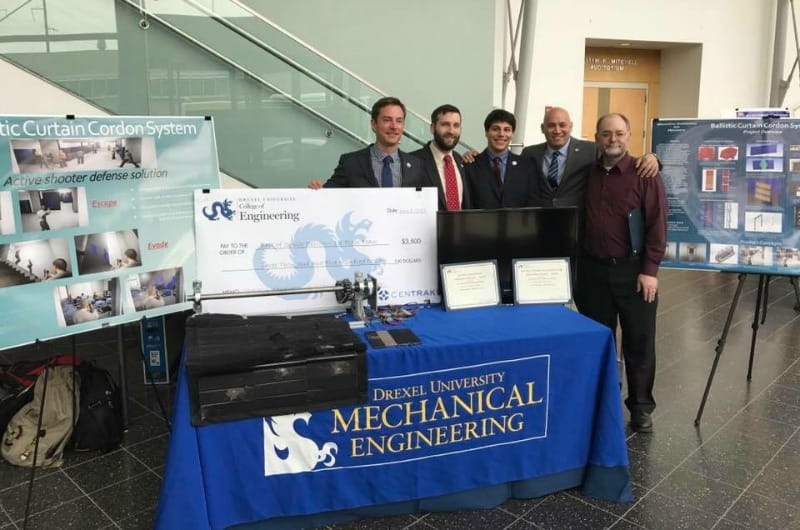The Drexel-Designed Device Aimed at Fixing an Epidemic
 By Ben Seal
By Ben Seal

The ballistic curtain team — from left to right: Daniel Navin, Peter Lewis, Fen Tamulonis and James Ostman — alongside faculty adviser Christopher Peters, PhD, after winning the College of Engineering's senior design competition.
James Ostman had just picked his wife up from the Harrisburg school she taught at when the two began a conversation most Americans have had. There had been yet another school shooting, and they couldn’t help but discuss the all-too-familiar details. In the days that followed, the conversation kept him up late at night, thinking about ways that someone could mitigate the harm done by the people perpetrating similar violent acts that have affected so many Americans in recent years.
Ostman, who just graduated from Drexel University’s College of Engineering with a bachelor’s in mechanical engineering, thought someone should make an effort to close up the wide-open spaces that allow sudden acts of violence to spread so quickly and to damage so many lives — and he could be that someone. His idea for a business built around creating protective barriers sat on the back burner for a year or so, until he paired up with Daniel Navin, a fellow 2017 mechanical engineering grad, for his senior project.
The result, which they call the Ballistic Curtain Cordon System, has the potential to be much more than a typical senior project. Last week it won first place and $6,000 in the College of Engineering’s Best of Senior Design competition, winning the overall and technical merit awards, but that’s just the beginning for Ostman, Navin and their team in their effort to help solve a dramatic problem.
“Violence’s ramifications can expand the more that the person inflicting the violence has the opportunity to reach out and touch what it is that he wants to harm,” said Ostman. “Taking something like an open space, it’s easy for someone who wants to inflict harm to take advantage of that situation. But when you start creating barriers, physical and visual, that’s where you can really interrupt that intent.”
That’s exactly what Ostman and Navin’s design accomplishes. Along with Peter Lewis, a mechanical engineering major, and Fen Tamulonis, an electrical engineering major, they created a prototype for a system of thin steel barriers that can be retrofitted into any ceiling and unfurl on command, creating a bulletproof set of obstacles to limit an attacker’s options. Ostman and Navin are both Army veterans, and they came up with the design by thinking back to their time on military bases in Iraq and Afghanistan, where large concrete walls function to halt the trajectory of any mortar and shrapnel that might come in.
“The curtain is kind of doing the same thing, turning an open area into a series of partitioned areas so bullets can’t travel,” said Navin.
The team has filed for a provisional patent on the curtain system and plans to continue working on the design after graduating, even with jobs lined up — Navin at General Dynamics, working on the nuclear submarine program, and Ostman in General Electric’s power generation division. They see it as something that would be appropriate for any school, office space, night club or municipal building to install as a measure of insurance against the type of tragedy that has occurred all across the country. Because the curtains are tucked away in a building’s ceiling, ready to drop whenever they are needed, they function similar to a fire alarm: an emergency solution activated by lever.
“You don’t want to turn a school into an up-armored bank vault,” said Navin. “You don’t want kids with that looming visual reminder all the time. So this is out of sight, out of mind.”
The design takes three to four seconds to unfurl, and then leaves a staggered series of six-foot-tall curtains in place, protecting anyone from six inches off the ground all the way to the top of their head. It can be used repeatedly, and the team created an administrative override so police can electronically pull the curtains back into the ceiling when they need to clear a scene. That part of the design was built after they went with a SWAT team to a school shooting training exercise to share their idea and gather feedback.
The prototype came after a long process of paring the design down to the simplest aspects of the idea, said Ostman. Navin knew from his time as an Army sniper that AR500 steel can take hundreds of shots without showing any effects, so the engineers used the steel to make the curtain bulletproof. Small plates are placed between sheets of nylon and held in place with Velcro bonded to the steel with silicone-based adhesives. The team estimates it would cost $200,000 to outfit an average building with adequate protections. But no cost can compare to the value of preventing another innocent victim, which is all Ostman and Navin are hoping for.
“If we can put ourselves in position to positively impact one of these situations, that would be enough for me,” said Ostman. “We would love to play a hand, because of this design, in actually mitigating one of these situations.”
Drexel News is produced by
University Marketing and Communications.
